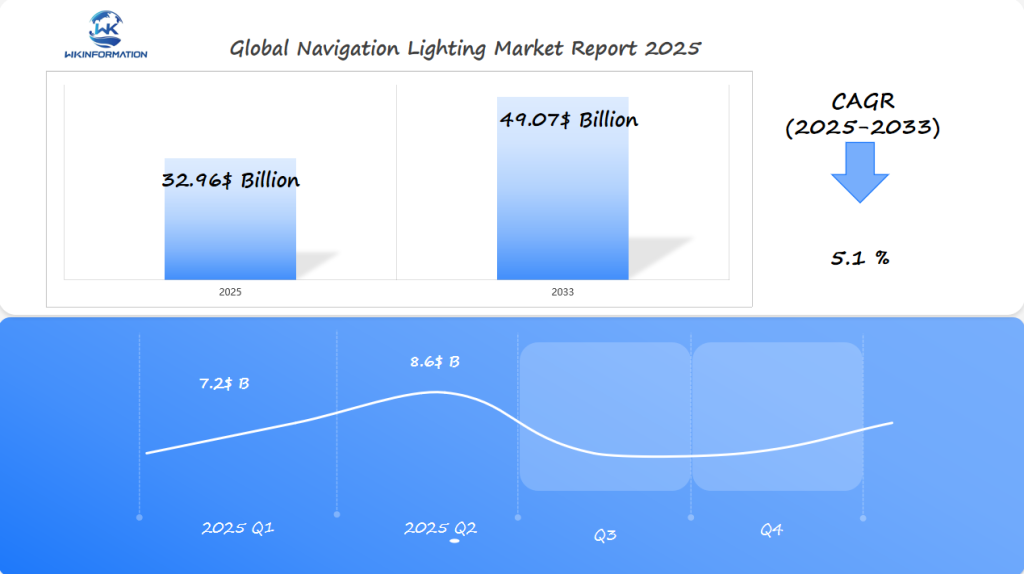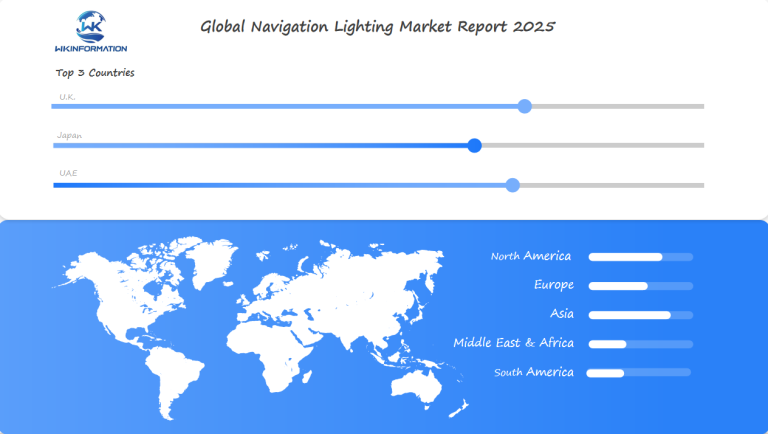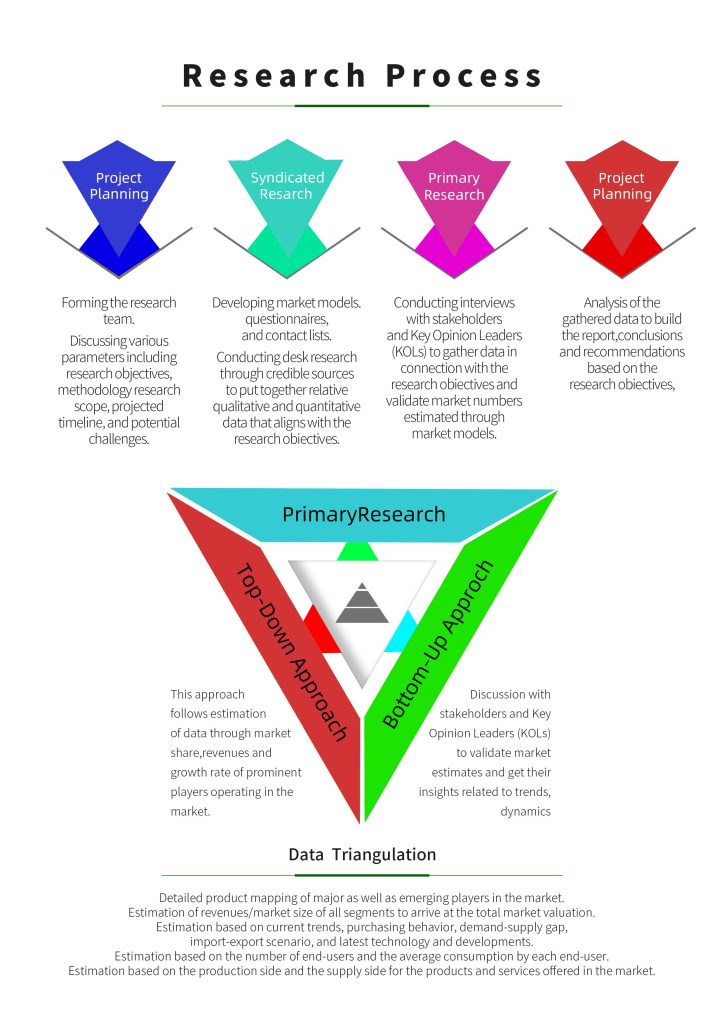Navigation Lighting Market to Surpass $32.96 Billion by 2025: Marine and Aviation Safety Standards Fuel Demand in the U.K., Japan, and the UAE
The global Navigation Lighting Market is expanding rapidly due to strict maritime safety regulations and growing air traffic. Rising demand across marine and aviation sectors drives market growth.
- Last Updated:
Navigation Lighting Market Performance in Q1 and Q2 of 2025
The global Navigation Lighting market is expected to reach $32.96 billion in 2025, supported by a CAGR of 5.1% from 2025 to 2033. Q1 projections are estimated at $7.2 billion, while Q2 shows an expected rise to $8.6 billion, driven by growing demand for advanced maritime infrastructure and aviation sectors. The growth in Q2 is especially marked by seasonal maritime activities and the enhancement of global port facilities.

Key Takeaways
- Navigation lighting market projected to reach $32.96 billion by 2025
- Technological innovations driving market expansion
- Increased focus on maritime and aviation safety regulations
- LED and smart lighting technologies gaining significant market share
- Growing investments in navigation lighting solutions
Analysis of the Upstream and Downstream Industry Chain in the Navigation Lighting Market
The navigation lighting market is a complex web of supply chain parts. Knowing the industry chain helps us understand how these parts work together. This is key to improving safety in both marine and aviation.
Raw material suppliers are crucial in the navigation lighting market. They provide advanced optical materials, special electronic parts, and durable lighting. These are the basics for top-notch navigation systems.
Key Components of the Supply Chain
- Raw material procurement from specialized manufacturers
- Electronic component integration
- Precision engineering and design
- Manufacturing processes
- Quality control and testing
Distribution channels for navigation lighting cover many areas. Companies sell directly to shipbuilders, plane makers, and even drone producers. This helps reach a wide range of customers.
| Market Segment | Distribution Channel | Primary End-Users |
| Maritime | Direct OEM Sales | Commercial Ships |
| Aviation | Specialized Retailers | Commercial Airlines |
| Emerging Technologies | Online Platforms | Drone Manufacturers |
Strategic partnerships between raw material suppliers and navigation lighting manufacturers drive technological advancement and market expansion.
Safety regulations and autonomous vessel systems push adoption
The navigation lighting industry is changing fast. This is thanks to new safety rules and advanced tech. The sea and sky are seeing big changes in lighting needs as more ships and planes fly on their own.
- IMO standards now require advanced lighting systems for better visibility of ships
- FAA rules are pushing for smart lighting integration in planes
- Autonomous ships need lights that can change and adapt quickly
Technological Integration in Navigation Safety
Modern safety rules are making lights smarter for safer travel. Sensor-integrated lights are key for self-driving ships. They give real-time info and help ships talk to each other better.
The International Maritime Organization has updated its rules for self-driving ships. These rules ask for lights that:
- Make ships more visible in busy waters
- Help ships talk to each other digitally
- Work well with new navigation systems
New tech for self-driving ships is leading to smarter lights. These lights are more intelligent and can respond quickly to safety rules.
Challenges: Harsh Weather Durability and Regulatory Compliance
Navigation lighting makers face big challenges. They need to make lights that last in tough weather and follow strict safety rules. The ability of lights to handle harsh weather is key for both the sea and air.
- Maintaining performance in extreme temperature ranges
- Resisting corrosive saltwater environments
- Withstanding high-impact mechanical stress
- Ensuring consistent visibility during severe weather conditions
Engineering Solutions for Harsh Weather Conditions
Companies are finding new ways to meet these challenges. They use advanced materials and designs. Now, navigation lights can work well in temperatures from -40°F to 140°F.
The big challenge for light makers is to keep lights durable and affordable. They must also follow strict safety rules. This pushes them to create lights that are top-notch in extreme weather and meet global safety standards.

Geopolitical focus on maritime control zones and flight safety laws
The navigation lighting industry is key in protecting maritime control zones and territorial waters. Governments around the world are setting strict lighting rules. This is to keep national security strong and follow international laws.
The modern maritime and aviation sectors face big challenges. They must keep safety high in different waters and air spaces. Important points include:
- Defining clear boundaries in contested maritime regions
- Establishing standardized lighting requirements
- Enhancing visibility during international transit
- Preventing potential navigational conflicts
International Lighting Standards for Maritime Zones
Navigation lighting is now a key tool for showing presence in important maritime areas. International law demands specific light rules. These help ships show their status, direction, and plans.
| Zone Type | Lighting Requirements | Regulatory Body |
| Coastal Waters | 360-degree visibility | International Maritime Organization |
| International Shipping Lanes | Color-coded navigation lights | COLREG Convention |
| Economic Exclusion Zones | Advanced tracking lights | National Maritime Authorities |
Flight safety laws are changing to meet new challenges, like drones in air space. Precise lighting is key to avoid aerial conflicts and ensure safe flight.
Navigation Lighting market segmentation by type: LED navigation lights, halogen, incandescent, solar-powered
The navigation lighting market offers various technologies to improve safety and visibility in the sea and sky. New lighting innovations have changed how we navigate through tough environments.
- LED navigation lights are the latest and most energy-saving option
- Halogen lights are reliable for traditional sea use
- Incandescent lights are still used in older navigation gear
- Solar-powered lights are a green and new choice
Technological Performance Characteristics
LED navigation lights are leading the market because they last long and use less power. They use about 80% less energy than old lights, making them popular for both work and fun boats.
Halogen lights are still important in tough weather. They keep visibility clear in hard sea conditions.
Market Evolution and Trends
The world of navigation lights is changing fast. Solar-powered lights are becoming more popular, especially for those who care about the environment. They save money and are better for the planet.
Incandescent lights are being replaced by newer, better options like LED and solar lights. This is because of new rules that want more energy-saving lights.
Navigation Lighting Market Segmentation by Application
The navigation lighting market covers important areas that need precise light technologies. Each area has its own challenges and new solutions for commercial ships, recreational boats, aircraft, and drones.
Commercial Maritime Navigation Lighting
Commercial ships need strong navigation lights that follow international safety rules. These lights must work well in harsh sea conditions. They help ships be seen and avoid collisions.
- High-intensity LED navigation lights
- Waterproof electrical systems
- Long-range visibility requirements
Recreational Boat Lighting Innovations
Recreational boats are using new lighting that’s safe and looks good. These lights are energy-saving and don’t take up much space.
Aircraft and Drone Navigation Lighting
Aircraft lighting is a complex area with strict rules. Drone lighting is growing fast, helping both work and fun drones.
| Application Segment | Key Lighting Requirements | Market Growth Projection |
| Commercial Ships | High-intensity, long-range visibility | 8-10% annual growth |
| Recreational Boats | Compact, energy-efficient designs | 6-7% annual growth |
| Aircraft | Regulatory compliant systems | 10-12% annual growth |
| Drones | Lightweight, adaptable technologies | 15-18% annual growth |
Every area of navigation lighting has its own tech progress. This is because of safety rules, performance needs, and new market wants.
Overview of the Global Navigation Lighting Market
The global navigation lighting market plays a crucial role in various industries and sectors. The growth of marine, aviation, and emerging transportation sectors is being driven by new technologies and safety regulations.
When we examine the global navigation lighting market, we observe different regions taking the lead and competing:
- North America is leading with its adoption of technology.
- Asia-Pacific is experiencing rapid growth.
- European markets are primarily focused on regulatory compliance.
Regional Market Dynamics
The competition in navigation lighting varies by region. New markets offer chances for tech and building growth.
Investments in research and development are changing the global navigation lighting market. Companies are making smart lighting with sensors. This improves performance and reliability in various transport areas.

U.K. Navigation Lighting market: maritime modernization and yachting
The UK navigation lighting market is at a key point. It blends new technology with old maritime traditions. The UK leads in making navigation lighting better for ships and boats.
The yachting world is key in making the UK’s maritime sector better. We see new trends, particularly with the rise of smart navigation lighting systems that enhance safety for all kinds of boats.
These advancements include better safety measures, more investment into technology, and the continuous evolution of LED technology. Furthermore, the industry is committed to following strict maritime rules to ensure safety and efficiency in navigation.
Technological Innovations Driving Market Growth
British makers are leading in creating new navigation lights. They focus on making lights that last long and use less energy. These lights must work well in harsh sea conditions.
What’s pushing the UK’s navigation lighting market forward includes:
- Strong maritime safety rules
- More people enjoying boating
- New tech in marine electronics
- More demand for green marine solutions
The mix of new tech and maritime tradition makes the UK a top player in navigation lighting. This opens up big chances for growth and new tech in the industry.
Japan's Navigation Lighting Market: Seaport Logistics and Smart Ships
Japan is at the forefront of maritime technology, making significant progress in navigation lighting. Its emphasis on seaport logistics and smart ships positions it as a global leader in maritime systems.
The Japan navigation lighting market is experiencing rapid growth due to several key factors:
- Advanced integration of smart ship technologies
- Innovative solutions in seaport logistics
- Complex navigation lighting systems
- Automated port infrastructure
Technological Leadership in Maritime Navigation
Japanese manufacturers have transformed navigation lighting with their innovative designs. Their focus on precision and reliability has significantly improved seaport logistics, resulting in more efficient sea travel.
Some of the groundbreaking advancements in smart ship technology include:
- Sensor-integrated navigation lights
- Real-time performance monitoring systems
- Energy-efficient lighting solutions
- Enhanced visibility in challenging maritime conditions
Global Market Impact
The Japan navigation lighting market is shaping global maritime tech. Japanese companies focus on safety, efficiency, and innovation. They’re setting new standards in navigation lighting for both commercial and military use.
UAE Navigation Lighting Market: Aviation Growth and Luxury Marine Segment
The United Arab Emirates is leading in navigation lighting innovation. It’s making big strides in aviation and marine tech. The UAE’s navigation lighting market is key for top-notch solutions that are safe and stylish.
Key developments in the region include:
- Rapid expansion of Dubai and Abu Dhabi as global aviation centers
- Significant investments in luxury marine infrastructure
- Stringent safety standards for navigation lighting systems
Innovations in Aviation Lighting
The aviation growth in the UAE has created a significant demand for advanced navigation lighting. Airports in Dubai and Abu Dhabi are currently testing new lighting technologies that enhance the visibility and safety of aircraft.
Changes in the Luxury Marine Segment
The luxury marine segment has also undergone a significant transformation. Specialized navigation lighting has become an essential element in yacht design. High-end yachts now incorporate:
- Smart LED navigation systems
- Adaptive lighting technologies
- Improved visibility features for maritime operations
Market Dynamics and Future Potential
The UAE is set to keep leading in navigation lighting innovation. It has the right mix of tech know-how, location, and investment. This makes it perfect for advanced lighting solutions in aviation and marine.
Future trend toward sensor-integrated smart lights
The navigation lighting industry is changing fast with the rise of sensor-integrated smart lights. New technologies are changing how we keep maritime and aviation safe and efficient.
IoT in navigation lighting is leading to big changes. These smart systems use advanced sensors to watch the environment and adjust lighting on the fly. New market trends show a big move towards AI in lighting.
Key Technological Innovations
- Advanced sensor integration for precise navigation
- Real-time environmental adaptation capabilities
- Energy-efficient intelligent lighting systems
- Automated collision prevention mechanisms
AI in lighting is changing how we navigate. These smart systems can change brightness, spot dangers, and send out safety info fast.
| Technology | Key Benefits | Implementation Potential |
| IoT Sensor Networks | Real-time monitoring | High |
| AI Navigation Algorithms | Predictive safety analysis | Medium-High |
| Adaptive Lighting Systems | Energy efficiency | High |
The future of navigation lighting is about combining smart tech for better safety, lower costs, and more awareness in the sea and sky.
Competitive dynamics across aviation, marine, and drone lighting providers
The navigation lighting industry is very competitive. Aviation, marine, and drone lighting companies are all vying for the top spot. Leaders are pushing the boundaries with new technologies and research.
Key Players:
-
Hella (Germany)
-
OSRAM (Germany)
-
Philips Lighting (Netherlands)
-
Stanley Electric (Japan)
-
Valeo (France)
-
Koito Manufacturing (Japan)
-
Magneti Marelli (Italy)
-
GE Lighting (USA)
-
Lumileds (USA)
-
Nichia (Japan)
Overall
| Report Metric | Details |
|---|---|
| Report Name | Global Navigation Lighting Market Report |
| Base Year | 2024 |
| Segment by Type |
· LED Navigation Lights · Halogen · Incandescent · Solar-powered |
|
Segment by Application |
· Commercial Ships · Recreational Boats · Aircraft · Drones |
| Geographies Covered |
· North America (United States, Canada) · Europe (Germany, France, UK, Italy, Russia) · Asia-Pacific (China, Japan, South Korea, Taiwan) · Southeast Asia (India) · Latin America (Mexico, Brazil) |
| Forecast units | USD million in value |
| Report coverage | Revenue and volume forecast, company share, competitive landscape, growth factors and trends |
Global Navigation Lighting Market Report (Can Read by Free sample) – Table of Contents
Chapter 1: Navigation Lighting Market Analysis Overview
- Competitive Forces Analysis (Porter’s Five Forces)
- Strategic Growth Assessment (Ansoff Matrix)
- Industry Value Chain Insights
- Regional Trends and Key Market Drivers
- Navigation Lighting Market Segmentation Overview
Chapter 2: Competitive Landscape
- Global Navigation Lighting Players and Regional Insights
- Key Players and Market Share Analysis
- Sales Trends of Leading Companies
- Year-on-Year Performance Insights
- Competitive Strategies and Market Positioning
- Key Differentiators and Strategic Moves
Chapter 3: Navigation Lighting Market Segmentation Analysis
- Key Data and Visual Insights
- Trends, Growth Rates, and Drivers
- Segment Dynamics and Insights
- Detailed Market Analysis by Segment
Chapter 4: Regional Market Performance
- Consumer Trends by Region
- Historical Data and Growth Forecasts
- Regional Growth Factors
- Economic, Demographic, and Technological Impacts
- Challenges and Opportunities in Key Regions
- Regional Trends and Market Shifts
- Key Cities and High-Demand Areas
Chapter 5: Navigation Lighting Emerging and Untapped Markets
- Growth Potential in Secondary Regions
- Trends, Challenges, and Opportunities
Chapter 6: Product and Application Segmentation
- Product Types and Innovation Trends
- Application-Based Market Insights
Chapter 7: Navigation Lighting Consumer Insights
- Demographics and Buying Behaviors
- TargetAudience Profiles
Chapter 8: Key Findings and Recommendations
- Summary of Navigation Lighting Market Insights
- Actionable Recommendations for Stakeholders

Access the study in MULTIPLEFORMATS
Didn’t find what you’re looking for?
TALK TO OUR ANALYST TEAM
Need something within your budget?
NO WORRIES! WE GOT YOU COVERED!
Call us on: +1-866-739-3133
Email: infor@wkinformation.com
What is the projected market size for navigation lighting by 2025?
The market for navigation lighting is expected to grow to $32.96 billion by 2025. This growth is due to stricter maritime safety rules and an increase in air travel worldwide.
What are the primary technologies used in navigation lighting?
The main technologies used are LED, halogen, incandescent, and solar-powered lights. LED lights are becoming more popular because they save energy and last longer.
How do safety regulations impact navigation lighting design?
Safety rules set by groups like the IMO and FAA push for new lighting tech. This is especially true for self-driving ships and planes.
What challenges do navigation lighting manufacturers face?
Companies must make lights that can handle harsh weather and meet changing rules. They also need to keep costs down while maintaining high quality.
Which industries use navigation lighting?
Navigation lights are essential for:
- Commercial ships
- Recreational boats
- Aircraft
- Military vessels
- Drones
How are smart technologies transforming navigation lighting?
Smart lights equipped with sensors, IoT (Internet of Things), and AI (Artificial Intelligence) are being developed. These innovative technologies aim to enhance navigation safety, reduce the risk of accidents, and promote energy efficiency.
Which regions are driving the growth of the navigation lighting market?
The growth of the navigation lighting market is being led by:
- The UK’s sea sector
- Japan’s smart shipping initiatives
- The UAE’s expanding air and sea industries
What are the key competitive strategies in the navigation lighting market?
Companies are innovating, forming partnerships, merging, and creating special solutions to meet new market needs.
How do geopolitical factors influence navigation lighting requirements?
Rules for sea and air zones affect light design. This is especially true for areas with disputes or high sensitivity.
What is driving the shift towards LED navigation lighting?
LED lights are better because they use less energy, last longer, and need less upkeep. They’re also more durable than old lights.

